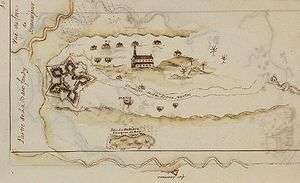Jeremiah Bancroft
Jeremiah Bancroft was born in Reading, Massachusetts, on July 27, 1725 and died there from smallpox on November 25, 1757. Bancroft was an ensign in the French and Indian War. Bancroft is best known for the diary he kept of his account of the fall of Fort Beausejour and the Expulsion of the Acadians at Grand-Pré.[1]
Family
His father Samuel was a captain in Reading. The Bancroft family had emigrated from England to Massachusetts in 1632 and Jeremiah was the third generation to have roots in Reading.[2] Jeremiah was an uncle of Judge Samuel Bancroft who moved with his family from Reading to the Annapolis Valley in 1762 and who is the progenitor of some, if not all, of the Bancroft families currently resident in Nova Scotia. In 1749 Jeremiah married Elizabeth Nichols and by the spring of 1755 when he embarked for Chignecto, Jeremiah and his wife had one daughter, a second child having died in infancy. Nothing is known of Jeremiah’s schooling. However, judging by his diary, it seems fair to conclude that he had received a basic education, being moderately literate and with a writing ability not unlike that of some other junior officers in the American colonial troops. His periodic reference to religious matters suggests that he was a man of faith, but that was probably the norm among mid-18th century New Englanders. Jeremiah was apparently not a wealthy man since the value of his estate was only a little over 66 pounds.
French and Indian War
Jeremiah Bancroft was the ensign in Captain Phineas Osgood’s Company, one of eleven companies comprising the First Battalion of the Regiment of Governor William Shirley of Massachusetts.[3] The Battalion was commanded by Lieutenant-Colonel John Winslow (British Army officer) of Marshfield, Massachusetts. It and a Second Battalion had been raised in New England, chiefly Massachusetts, in the early months of 1755 by Governor Shirley and Lieutenant Colonel Robert Monckton. At the time that Captain Osgood’s Company embarked at Boston on the Swan for Chignecto, it numbered 103 officers and men. All together, the assault force consisted of approximately 1,950 New England provincial troops and 270 British regulars.

The first entry of Bancroft's diary relates to the successful Battle of Fort Beauséjour by an assault military force. The capture of Fort Beauséjour was the only instance in which New France was compelled to yield ground in 1755, a year which was generally disappointing for Great Britain in its undeclared war with France.
Bancroft’s second entry in his diary relates to a gloomy chapter in Maritime history—the Expulsion of the Acadians of Nova Scotia. More specifically, it relates to operations at Grand-Pré. While several other diaries chronicle events during and after the siege of Fort Beauséjour, including the deportation of Acadians from the Chignecto area, only one other diary is known to record events attending the deportation in 1755 of Acadians living farther south in Nova Scotia.
References
- ↑ Jonathan Fowler and Earle Lockerby (2009). Operations at Fort Beausejour and Grande Pre in 1755: A soldier's diary. The Royal Nova Scotia Historical Society Journal pp.145-184
- ↑ Jonathan Fowler and Earle Lockerby (2009). Operations at Fort Beausejour and Grande Pre in 1755: A soldier's diary. The Royal Nova Scotia Historical Society Journal p.146
- ↑ Jonathan Fowler and Earle Lockerby (2009). Operations at Fort Beausejour and Grande Pre in 1755: A soldier's diary. The Royal Nova Scotia Historical Society Journal p.147